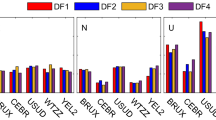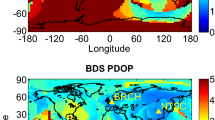Abstract
In this study, a model of precise time transfer is developed based on the triple-frequency un-combined observations of the BeiDou navigation satellite system, known as UC-PPP. In this model, except for the traditional position, troposphere delay and receiver clock parameters, ionosphere delays are estimated as unknown parameters by adding the prior, spatial and temporal constraints. In addition, receiver differential code biases (DCB) are also estimated as unknown parameters. The standard triple-frequency ionosphere-free model is also introduced, named as IF-PPP. To assess the performance of the model, datasets with short baseline and common external time frequency are used. The results show that the triple-frequency UC-PPP model can be used for precise time transfer, with accuracy and stability identical to those of the IF-PPP model. The model can also provide the receiver DCB and ionosphere total electron content products.










Similar content being viewed by others
References
Bock H, Hugentobler U, Beutler G (2003) Kinematic and dynamic determination of trajectories for low Earth satellites using GPS. In: Reigber C, Luhr H, Schwintzer P (eds) First CHAMP mission results for gravity magnetic and atmospheric studies. Springer, Heidelberg, pp 65–69
Delacy M, Sanso F, Gil A, Rodriguez-Caderot G (2005) A method for ionospheric delay estimation and interpolation in a local GPS network. Stud Geophys Geod 49:63–84
Feng Y (2008) GNSS three carrier ambiguity resolution using ionosphere-reduced virtual signals. J Geod 82(12):847–862
Geng J, Bock Y (2013) Triple-frequency GPS precise point positioning with rapid ambiguity resolution. J Geod 87(5):449–460
Guo F, Zhang X, Wang J (2015) Timing group delay and differential code bias corrections for BeiDou positioning. J Geod 89(5):427–445
Guo F, Zhang XX, Wang JL, Ren XD (2016) Modeling and assessment of triple-frequency BDS precise point positioning. J Geod 90(11):1223–1235
Hatch R, Jung J, Enge P (2000) Civilian GPS: the benefits of three frequencies. GPS Solut 3(4):1–9
Jiang Z, Czubla A, Nawrocki J, Lewandowski W, Arias EF (2015) Comparing a GPS time link calibration with an optical fibre self-calibration with 200 ps accuracy. Metrologia 52(2):384–391
Johnston G, Riddell A, Hausler G (2017) The International GNSS Service. In: Teunissen P, Montenbruck O (eds) Handbook of global navigation satellite systems, chapter 7. Springer, Berlin. https://doi.org/10.1007/978-3-319-42928-1
Larson KM, Levine L (1999) Carrier-phase time transfer. IEEE Trans Ultrason Ferroelectr Freq Control 46(4):1001–1012
Li B, Shen Y, Zhang X (2013) Three frequency GNSS navigation prospect demonstrated with semi-simulated data. Adv Space Res 51(7):1175–1185
Montenbruck O, Steigenberger P (2013) The BeiDou navigation message. J Glob Posit Syst 12(1):1–12
Montenbruck O, Steigenberger P, Prange L, Deng Z, Zhao Q, Perosanz F, Romero I, Noll C, Stürze A, Weber G, Schmid R, MacLeod L, Schaer S (2017) The multi-GNSS experiment (MGEX) of the International GNSS Service (IGS)—achievements, prospects and challenges. Adv Space Res 59(7):1671–1697
Plumb JF (2003) Carrier phase time transfer using the global positioning system. Ph.D. thesis, University of Colorado, Colorado
Richert T, El-Sheimy N (2007) Optimal linear combinations of triple frequency carrier phase data from future global navigation satellite systems. GPS Solut 11(1):11–19
Shi C, Zhao Q, Hu Z, Liu J (2013) Precise relative positioning using real tracking data from COMPASS GEO and IGSO satellites. GPS Solut 17(1):103–119
Spit J (2011) Total electron content reconstruction using triple frequency GNSS signals. Ph.D. thesis, University of Liege
Tu R, Ge M, Huang G, Zhang H (2013) The realization and convergence analysis of combined PPP based on raw observation. Adv Space Res 52:211–221
Tu R, Zhang P, Zhang R, Lu C, Liu J, Lu X (2017) The study and realization of BDS un-differenced network-RTK based on raw observations. Adv Space Res 59:2809–2818
Weber R, Karabatic A (2009) Potential improvements in GNSS-based troposphere monitoring by use of upcoming GALILEO signals. In: Proceedings 2nd colloquium-scientific and fundamental aspects of the Galileo program
Yang YX, Li JL, Wang AB, Xu JY, He HB, Guo HR, Shen JF, Dai X (2014) Preliminary assessment of the navigation and positioning performance of BeiDou regional navigation satellite system. Sci China Earth Sci 57(1):144–152. https://doi.org/10.1007/s11430-013-4769-0
Acknowledgements
The work was partly supported by the program of National Key Research and Development Plan of China (Grant No: 2016YFB0501804), National Natural Science Foundation of China (Grant Nos: 41504006, 41674034) and Chinese Academy of Sciences (CAS) programs of “Pioneer Hundred Talents” (Grant No: Y620YC1701) and “The Frontier Science Research Project” (Grant Nos: QYZDB-SSW-DQC028) and “Funded by State Key Laboratory of Geo-information Engineering, No. SKLGIE2016-M-2-4.”
Author information
Authors and Affiliations
Corresponding author
Rights and permissions
About this article
Cite this article
Tu, R., Zhang, P., Zhang, R. et al. Modeling and performance analysis of precise time transfer based on BDS triple-frequency un-combined observations. J Geod 93, 837–847 (2019). https://doi.org/10.1007/s00190-018-1206-3
Received:
Accepted:
Published:
Issue Date:
DOI: https://doi.org/10.1007/s00190-018-1206-3




